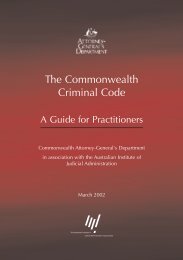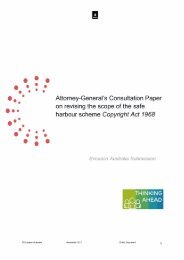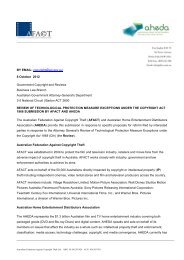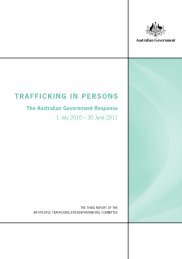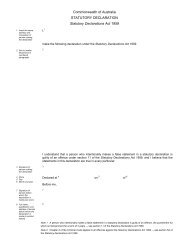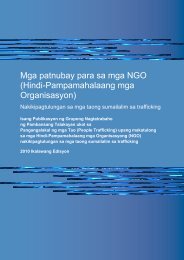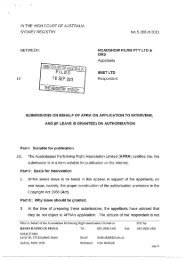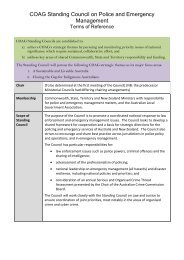Normann Witzleb [PDF 657KB] - Attorney-General's Department
Normann Witzleb [PDF 657KB] - Attorney-General's Department
Normann Witzleb [PDF 657KB] - Attorney-General's Department
You also want an ePaper? Increase the reach of your titles
YUMPU automatically turns print PDFs into web optimized ePapers that Google loves.
36 The ALRC does not provide any arguments why the privacy action should be limited in<br />
that way. 52 It merely refers to the Consultation Paper of the NSWLRC, which suggested<br />
that liability for negligent or accidental acts in relation to all privacy invasions ‘would,<br />
arguably, go too far’. 53 However, in its final report the NSWLRC no longer recommends<br />
such a limitation. The VLRC likewise regards it as unnecessary expressly to exclude<br />
negligent acts. 54 The NSWLRC proposal now provides that, for a finding of liability, the<br />
court must take into account, amongst other things, ‘the nature of the conduct<br />
concerned (including the extent to which a reasonable person of ordinary sensibilities<br />
would consider the conduct to be offensive)’ 55 and ‘the conduct of the individual and<br />
the alleged wrongdoer both before and after the conduct concerned (including any<br />
apology or offer to make amends made by the alleged wrongdoer)’. 56 As a court may<br />
also take into account any other matter it considers relevant, this would allow for the<br />
degree of fault (if any) of the wrongdoer to be taken into account. In addition, the<br />
NSWLRC recommends a defence of innocent dissemination, 57 which is familiar from the<br />
law of defamation.<br />
Comment<br />
37 There are two difficulties with the recommendation of the ALRC that only intentional<br />
and reckless invasions of privacy should be actionable. Firstly, its intended meaning is<br />
unclear. Secondly, it is difficult to justify on policy grounds. In relation to meaning, the<br />
ALRC report does not make clear with respect to which elements of the cause of action<br />
the defendant must have acted recklessly or intentionally. The ambiguity stems from the<br />
fact that the ALRC recommends that reckless or intended ‘acts’ are actionable but an<br />
invasion of privacy is a composite cause of action with multiple elements. These<br />
elements are that the plaintiff has a reasonable expectation of privacy, that the act or<br />
conduct complained of is highly offensive to a person of ordinary sensibilities and that,<br />
on balance, the plaintiff’s privacy interest outweighs countervailing public interest<br />
considerations.<br />
38 It is widely acknowledged that there is much confusion in the use of the terms<br />
intention and recklessness. 58 In torts law, there are some torts where the defendant’s<br />
conduct needs to have been intended and others where that conduct’s consequences<br />
for the plaintiff need to have been intended. 59 Even though the proposed privacy action<br />
is not a tort, there needs to be clarity with regard to which elements of the cause of<br />
action the defendant must have had mens rea. At its simplest, it could be argued that<br />
recklessness only needs to exist in relation to the ‘act or conduct’ element of the cause<br />
52 ALRC Report, at [74.164].<br />
53 NSWLRC, Invasion of Privacy, Consultation Paper 1, 2007, at [7.24].<br />
54 VLRC Report, at [7.148].<br />
55 NSW Draft Bill, cl 74(3)(a)(ii).<br />
56 NSW Draft Bill, cl 74(3)(a)(vi).<br />
57 NSW Draft Bill, cl 75(1)(d).<br />
58 See, eg, F Trindade, P Cane and M Lunney, The Law of Torts, 4 th ed (Oxford: OUP), 2007, 270<br />
(‘terminological minefield’); P Cane, ‘Mens Rea in Tort Law’ (2000) 4 Oxford Journal of Legal Studies 533;<br />
S Yeo, ‘Comparing the Fault Elements of Trespass, Action on the Case and Negligence’ (2001) 5 Southern<br />
Cross University Law Review 142.<br />
59 See, eg, F Trindade, P Cane and M Lunney, ibid, 269-270.<br />
13


![Normann Witzleb [PDF 657KB] - Attorney-General's Department](https://img.yumpu.com/26247895/13/500x640/normann-witzleb-pdf-657kb-attorney-generals-department.jpg)

